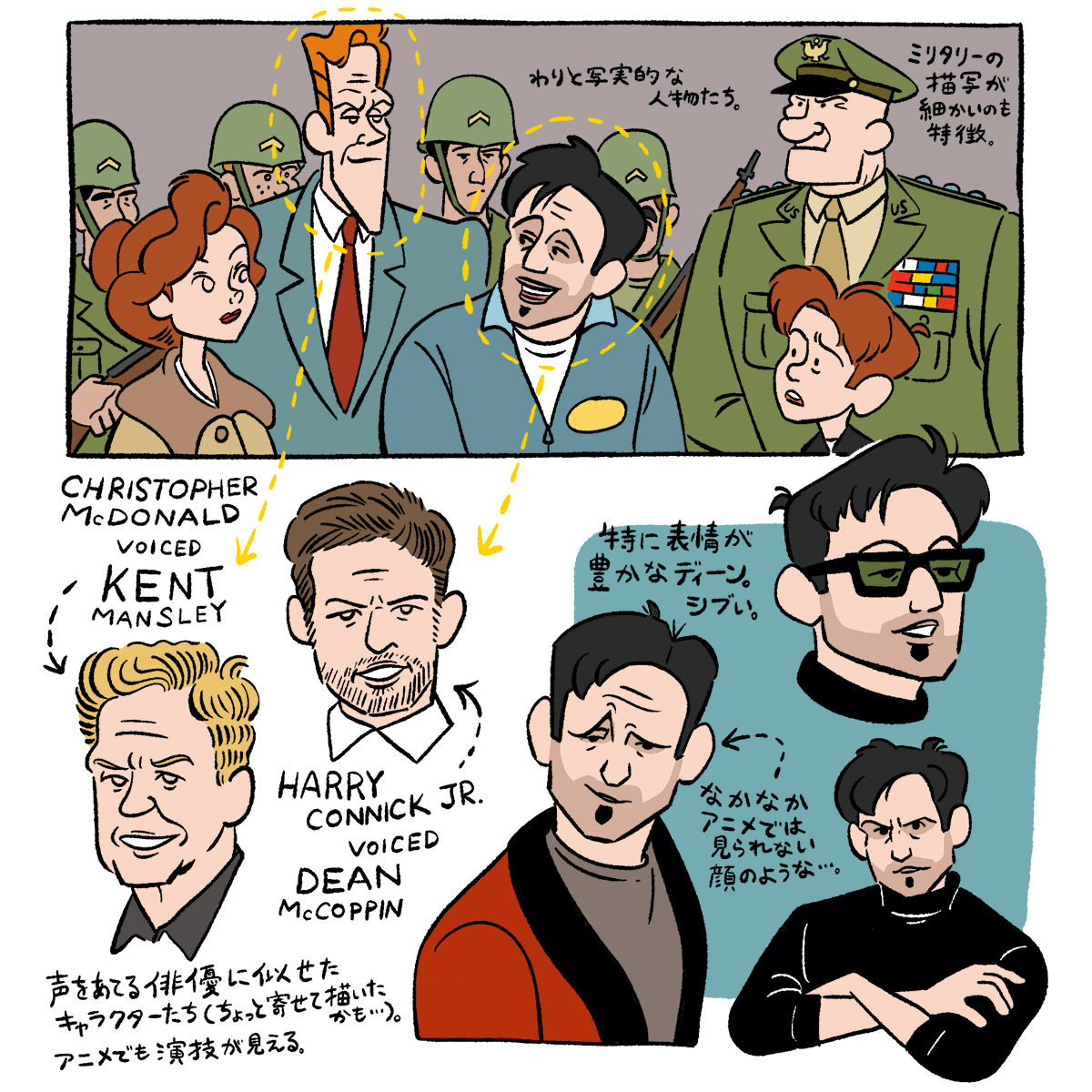It was actually a pretty realistic anime.

What I noticed when I rewatched it for the first time in a while was how real the characters are. At first glance, it feels like an American animation with a tone similar to Disney works, but the characters in this film seem to have a low level of energy overall for an animation. They are certainly caricatured, deformed and exaggerated to a certain extent, but there is not much clarity in the way they have extreme body shapes or exaggerated gestures. What is most noticeable is the voice acting; there is no artificial tone of voice or high energy, and it seems like everyone is acting in a uniformly normal way. In other words, it is normal movie acting.
This seems to be reflected in the character designs, especially two of the main characters, Dean McCoppin and Kent Munsley, who are voiced by Harry Connick Jr. and Christopher McDonald (who also played Robin in Flubber ).・He has a vague resemblance to Williams (who was Williams' antagonist).
Dean is a strange guy who runs a scrapyard and makes art out of scrap materials, but he's pretty cool. Because the giant eats iron, he hides it in a scrapyard and shares the secret of the giant robot with Hogarth, but after losing his father, Hogarth is a dependable adult man whom he hasn't seen in a long time, and is like a father figure. But I like that he's also like an older brother.
I like the scene where Hogarth, excited after drinking coffee for the first time at Dean's house in the middle of the night, vents out his pent-up frustrations from the past day. Adults other than parents who listen to me have a strange sense of distance and familiarity that is different from seniors or friends. The rich and human expressions that Dean shows are also great.
Kent is a government investigator who arrived in the port city after receiving a report of an incoming object, but as soon as he learns of the existence of the giant robot that Hogarth encountered, he concludes that it is an Eastern weapon and tries to eliminate it at all costs. He is sensitive to threats and seems to be a little hysterical (although in the anime, it is made to look a little comical), but this is understandable given that he was in the midst of the so-called Sputnik Shock, just after the launch of Sputnik 1. A Soviet artificial satellite orbited the Earth before the United States. For the Americans at the time, it must have been like the enemy had taken something higher than air superiority, and Kent's character is an easy-to-understand way of expressing that psychological state.
When interrogating Hogarth and trying to find out the whereabouts of the robot, he even shows despicableness by exploiting the weaknesses of a single-parent family and blackmailing him, but he is basically stupid, and while he is a villain, he is also comic relief. In contrast to Dean's sour expression, Kent's is a bit more revealing, and although this one is more cartoon-like (perhaps because his thoughts are simpler than Dean's), he still opens his mouth and laughs out loud. He does not take on the appearance of a villain, but rather remains an expression of a normal human being possessed by fear and hostility.
In any case, Dean, who listens to Hogarth's words and gives him advice, and Kent, who takes a coercive attitude towards Hogarth (and his mother Annie), are in contrast, and a boy without a father sees two completely different fathers. Show the statue.
When I try to imitate it and draw it in this way, I think the human face is well expressed with just a few lines. The exaggeration of features such as the nose, eyes, and contours is kept to a minimum (Kent is the most exaggerated among them, but that's probably because of his character), and to put it simply, it's not boring. . It is also impressive that the eyes are generally drawn small, and this may be what gives the facial expressions a sense of realism. On the other hand, the ears are drawn larger, but I wonder if the outline is balanced. Even if I draw the faces of actors as characters in movies, drawing human faces is still difficult and something I'm not good at, so this is a great learning experience for me.

![“The Iron Giant” as a picture-perfect movie [Mizumaru Kawahara’s CINEMONOLOGUE Vol.44]](https://cinemore.jp/images/77e7d3e43fce0e88f0580fbf55e4bf2ad7ec9e94c1da7a4612a2fb1070cf4a09.jpg)
